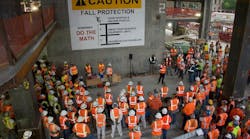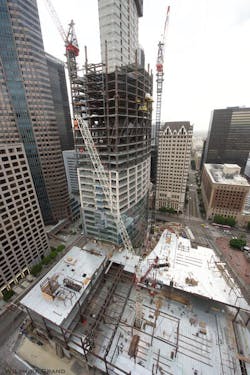Building the Wilshire Grand Hotel: Reaching New Heights with Safety
The new Wilshire Grand Hotel is rising 73 stories above Los Angeles. When complete, it will be the tallest building in the city – and west of the Mississippi River.
The skyscraper, with its 70th floor sky lobby, observatory and skypool deck, will require the labor of about 850 people – electricians, plumbers, concrete workers – all working together high above the rooftops of L.A.
Gavin Banks, safety director of the southern California business unit of Turner Construction, is responsible for keeping all of those workers safe.
“There’s a bigger risk here because of how high you’re going. You have to put in a higher level of preplanning and detail,” Banks said. “It’s just more complicated.”
But at its core, the construction of the marquee building is really just a matter of economy of scale.
“It’s the same game plan, just more preplanning, more attention to detail,” Banks said. “You follow the same processes, just to scale.”
That game plan means creating a culture of safety that pervades all parts of the business.
“We want safety people to be looked at as coaches and mentors and a resource,” Banks said. “The old days of cops and robbers are in the past.”
Rather than establishing a safety program driven by compliance, Banks encourages the collaboration of safety and operations to “go beyond compliance.” Such a culture fosters more engagement and cooperation and moves away from the us-versus-them mentality.
“I think really it’s like a top-down, bottom-up approach to safety. You’re engaging and empowering the workers and always looking for ways to continuously improve upon what we’re doing,” Banks said.
“With construction, it’s such a transient workplace. The biggest challenge is how you build that culture and how you sustain it. Once people get on board with it and live and breathe it, it becomes contagious.”
All One Team
For the Wilshire Grand project, there are about 20 safety people on site, five of whom are Turner employees. However, despite working for different companies, all of the safety personnel wear the same signature blue safety vests with “Wilshire Grand” emblazoned on the back.
“The goal is that we’re all one team,” Banks said.
To engage workers in safety for such an inherently risky project, the safety team asked them to come up with a slogan for one of the two biggest hazards on site: tools and materials dropping.
“It’s a downtown L.A. street. There are pedestrians and vehicle traffic on all four sides of you,” Banks said.
Using the “Stop the Drop” slogan, the safety team encourages workers to use tool lanyards next to the leading edge and to keep materials away from the edges of the building.
“It’s simple, but it’s meaningful because they brought it to us,” Banks said.
To address the oth“On normal structures, floor heights normally don’t deviate from each other. You have to do the math for fall protection. You constantly need to be thinking about the height,” Banks said. “That’s what makes it kind of unique.”
Banks, who has been in the field for 17 years, earned a degree in occupational safety and health and then worked his way up the safety ladder.
Now, in his role as a safety director at Turner, he oversees a team of 22 safety professionals across southern California, Arizona and Nevada. He attributes his success to his approach to safety leadership and the team-based approach to safety.
“It goes back to being a coach and a mentor and listening to people. When you talk to workers in the field, you have to show them respect. At the end of the day, they’re the professionals at what they do,” he said.
“One person can’t make as big of a cultural impact as many people. That’s why for me the safety culture piece of it has been important.”

